Share This :
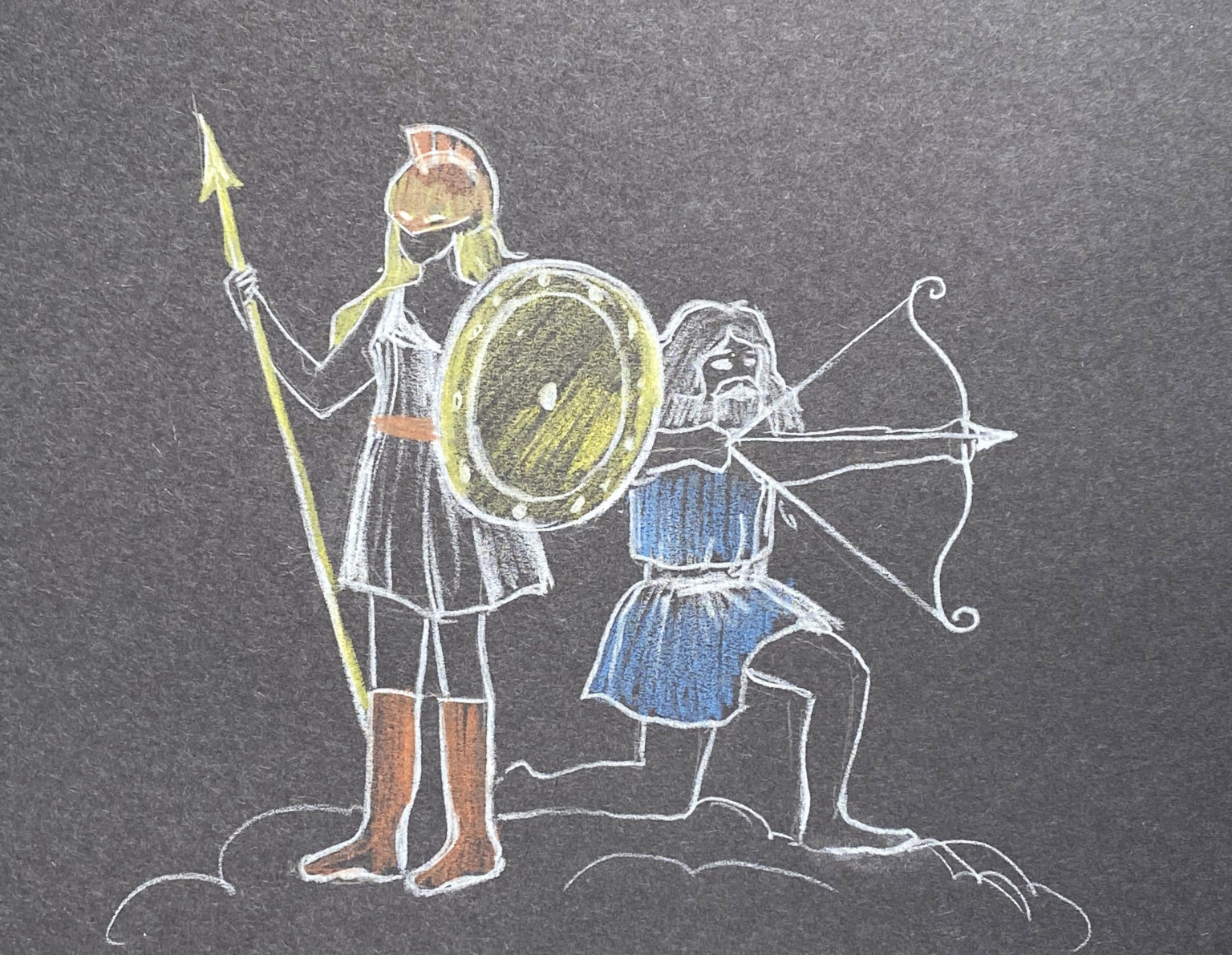
For the ancient Greeks the world was created out of nothing which they called Chaos.
So as for some other Greek words the original meaning of the word has been mistaken and is now used with a whole different meaning : chaos didn’t meant disorder but nothingness, just like “apocalypse” meant “revelation “ and is now translated as “the end of the world “.
Born from the void of Chaos and from the light were the first primordial gods :
-Aether ( Brightness) and Day (Hemera),
-Moros (Destiny)
-The Keres (Destruction, Death)
-Thanatos (Death)
-Hypnos ( Sleep)
-the Oneroi (Dreams)
-Momus (Blame)
-Oizys (Pain, Distress)
-The Hesperides (the Daughters of the evening)
-The Moira ( Fates : the 3 goddesses who determined human destinies especially the duration of one’s life and his share of misery.
There were 3 sisters: Clotho (the spinner) , Lachesis (the alloter) and Atropos (the inflexible).
-Nemesis (Indignation, Retribution)
-Apate (Deceit)
-Philotes(Friendship)
-Geras (Old Age)
-Eris (Strife)
At this beginning of the time, from the union between Earth and the Sky, Gaia and Uranus , three very different sets of children were born :
There arose a problematic situation : Uranus was not exactly an infatuated, over indulgent father. Profoundly disgusted by his own descendants , the Hecatoncheires and the Cyclops he threw them back into Gaia’s womb which infuriated her and she therefore decided to help her favourite Titanic son Cronus to overthrow her husband.
Cronus now with the efficient help of his mother overthrew his father by cutting his genitals. He then threw also his devoted mother with his castrated father into Tartarus to be sure to be definitely liberated from them.
Cronus and Rhea : The Time of the Titans
Cronus was married with his sister Rhea.
He was obsessed with power and lived in fear of being overthrown by one of his children, probably as he did so with his own father.
Therefore to be sure to keep the absolute control over the cosmos, he made sure to eat all his newborns. Problem solved !
“No child, no risk “ was obviously his motto.
After watching her husband eat their fifth child, Rhea decided, just as Gaia previously, that she could not take it anymore and decided to trick her mighty selfish husband. “Enough was enough !”
When she gave birth to her sixth child, she hid him immediately in a cave on Mount Ida in Crete. Back home she gave to her cannibal husband a stone wrapped in a blanket. Fortunately he did not make the difference and that was the first trick to many which will bring him down.
This betrayal driven by the maternal instinct , shows that Cronus did not fully understood how he was raised to power. His hubris prevented him to admit the help of his mother who was also driven by her maternal instinct. His arrogance allows the story to start.
The baby ‘s name was Zeus, the milk provider was a goat named Amalthea with an infinite supply of milk and the baby sitting was ensured by a pack of beautiful, loving nymphs and joyful satyrs : what an education for the young Zeus !
Zeus would be forever grateful towards his protectors. Later he would prove his gratitude :
– by ripping one of the horn from Amalthea and giving it to the nymphs and satyrs who took such a good care of him. This extraordinary horn would provide for the whole eternity, whatever the nymphs and satyrs are fond of : fruits, flowers, jewels… This horn will be known as The Cornucopia.
To thank for eternity Almathea , Zeus will raised her in the cosmos as part of a constellation .
Now a grown up, Zeus had no other option but to kill his father before his father learned the truth and killed him.
Zeus knew that he needed allies to win. So he concluded a deal with the Giants who had sprung from the blood of Uranus and were completely mistreated by the Titans.
He even managed to convince one of the Titan’s leaders : Prometheus to overthrow Cronus.
Prometheus was a very special Titan : he had high moral ethics and he teamed up with Zeus as he could not accept any longer Cronus abuses of power ( much later he would also fight Zeus).
Zeus was able to trick Cronus to vomit his immortal brothers and sisters. Not only they were alive but they had been growing up inside Cronus and were perfect grown ups ready to fight.
The war was named the Titanomachy or the Battle of the Gods. It was a long and arduous war to decide which generation of gods would rule. Finally Zeus and his allies defeated Cronus and the Titans.
The Giants were freed.
Prometheus, the Titan, was granted the pardon of his brother Epimetheus as his reward.
Cronus was sent to Tartarus, a hellish place of dire exile.
Atlas, one of the most fierce Titans who had been so difficult to defeat because of his titanic strength , was condemned to hold on his shoulders the Earth, blocking him to do anything else.
What about the other Titans ? They were all trapped beneath the Earth, it is certainly the reason why there are volcanic eruptions and earthquakes : the Titans trapped underneath are fuming and desperate to free themselves.
Zeus chose the highest mountain of Greece, Mount Olympus as the gods’s new home.
But the Giants wanted more than freedom. They were hungry for power.
One night they attacked Olympus when Zeus and his brothers were too drunk to notice anything .
The most important divine struggle in Greek mythology is the Gigantomachy, the battle fought between the Giants and the Olympian gods for the supremacy of the cosmos.
The Giants were the forces of disorder and darkness.
Thankfully that night the pet eagle of Zeus was sober and woke them up just in time.
Still their situation was quite desperate facing the whole army of the Giants.
Zeus decided to use for the first time his weapon of massive destruction : lightning!
He sent a lightning which pulverised the whole army of Giants.
Zeus after this red alert decided that ruling the world was after all a serious business and he needed help. It was time to delegate and to organise the world.
So he gave the seas to rule to Poseidon and the underworld to Hades, keeping Mount Olympus, the earth and the sky for himself.
The Olympian gods were now ruling.
Declare to me from the beginning, you Mousai who dwell in the house of Olympos, and tell me which of them first came to be
In truth at first Khaos (Air) came to be, but next wide-bosomed Gaia (Earth), the ever-sure foundation of all the deathless ones who hold the peaks of snowy Olympos, and dim Tartaros (the Pit) in the depth of the wide-pathed Earth, and Eros (Love), fairest among the deathless gods, who unnerves the limbs and overcomes the mind and wise counsels of all gods and all men within them.
From Khaos (Air) came forth Erebos (Darkness) and black Nyx (Night); but of Nyx (Night) were born Aither (Light) and Hemera (Day), whom she conceived and bore from union in love with Erebos. And Gaia (Earth) first bore starry Ouranos (Heaven), equal to herself, to cover her on every side, and to be an ever-sure abiding-place for the blessed gods. And she brought forth long Ourea (Mountains), graceful haunts of the goddess Nymphai who dwell amongst the glens of the hills. She bore also the fruitless deep with his raging swell, Pontos (Sea), without sweet union of love.
But afterwards she [Gaia, Earth] lay with Ouranos (Heaven) and bare deep-swirling Okeanos, Koios and Krios and Hyperion and Iapetos, Theia and Rhea, Themis and Mnemosyne and gold-crowned Phoibe and lovely Tethys. After them was born Kronos the wily.»
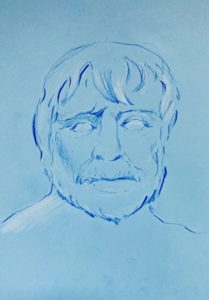 In the time of Homer, around 750 and 650 BCE , Hesiod was a celebrated poet who is to our days still the major source about Greek mythology.
In the time of Homer, around 750 and 650 BCE , Hesiod was a celebrated poet who is to our days still the major source about Greek mythology.
He is also described as “the father of Greek Didactic Poetry” and the “first economist “.
He himself attributed his poetic gifts to the Muses, who appeared to him while he was a simple shepherd in the peaceful countryside. The beautiful muses offered him a poet’s staff and endowed him with a poet’s voice to “sing about the race of the blessed gods immortal.”
Only two of his entire epics have survived :
narrating the genealogy, the power struggle and the lives of the gods and goddesses.
He retraced the creation of the world and the different reigns of the gods, naming more than three hundred gods.
Many other authors have written on this subject over the centuries but The Theogony remains since the ancient times the most respected source..
is about the lives of farmers, peasants and shepherds , giving moral consideration and practical advice.
The poem is a farmer’s almanac in which Hesiod instructs his brother Perses in the agricultural arts.
For this , he is also considered as the father of economists : “Through work, men grow rich in flocks and substance … 381] If your heart within you desires wealth, do these things and work with work upon work….”
In the poem there are also practical advice :
“Never take water in the mouths of rivers which flow to the sea, nor yet in springs; but be careful to avoid this. And do not ease yourself in them: it is not well to do this”.
“Call your friend to a feast; but leave your enemy alone; and especially call him who lives near you: for if any mischief happen in the place, neighbours come ungirt, but kinsmen stay to gird themselves. A bad neighbour is as great a plague as a good one is a great blessing;”
And Morals
“Let the wage promised to a friend be fixed; even with your brother smile — and get a witness; for trust and mistrust, alike ruin men”.
“ Be friends with the friendly, and visit him who visits you. Give to one who gives, but do not give to one who does not give”.
And more importantly, the one that your mother keeps nagged you with :
“Do not put your work off till to-morrow and the day after;
for a sluggish worker does not fill his barn, nor one who puts off his work: industry makes work go well, but a man who puts off work is always at hand-grips with ruin”.
Pandora and the Jar
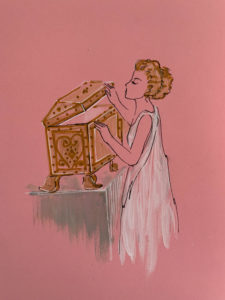 After Zeus realised that Prometheus had stolen the fire to give it the men …
After Zeus realised that Prometheus had stolen the fire to give it the men …
“Zeus who delights in thunder did not see it. But afterwards Zeus who gathers the clouds said to him in anger: `Son of Iapetus, surpassing all in cunning, you are glad that you have outwitted me and stolen fire — a great plague to you yourself and to men that shall be. But I will give men as the price for fire an evil thing in which they may all be glad of heart while they embrace their own destruction”….
… “And he charged Hermes the guide, the Slayer of Argus, to put in her a shameless mind and a deceitful nature”…
… The messenger of the gods, to take it to Epimetheus as a gift. And Epimetheus did not think on what Prometheus had said to him, bidding him never take a gift of Olympian Zeus, but to send it back for fear it might prove to be something harmful to men. But he took the gift, and afterwards, when the evil thing was already his, he understood” …
… But the woman took off the great lid of the jar with her hands and scattered all these and her thought caused sorrow and mischief to men. Only Hope remained there in an unbreakable home within under the rim of the great jar, and did not fly out at the door; for ere that, the lid of the jar stopped her, by the will of Aegis-holding Zeus who gathers the clouds. But the rest, countless plagues, wander amongst men; for earth is full of evils and the sea is full. Of themselves diseases come upon men continually by day and by night, bringing mischief to mortals silently; for wise Zeus took away speech from them. So is there no way to escape the will of Zeus”….
The Ages of Man : the creation of Mankind
Cronus first and then Zeus each created a race of mortals to populate the earth and to entertain the gods.
But even for the mighty gods, the results were so utterly disappointing that they had to erase them from the surface of the earth.
Zeus tried 4 times to create appropriate mortals, giving them each time different characteristics.
We, as present human beings are his fifth attempt and the result as Hesiod described us is quite sad and dark but might it not be extraordinarily accurate ?
“And again far-seeing Zeus made yet another generation, the fifth, of men who are upon the bounteous earth…
…Thereafter, would that I were not among the men of the fifth generation, but either had died before or been born afterwards. For now truly is a race of iron, and men never rest from labour and sorrow by day, and from perishing by night; and the gods shall lay sore trouble upon them. But, notwithstanding, even these shall have some good mingled with their evils. And Zeus will destroy this race of mortal men also when they come to have grey hair on the temples at their birth. The father will not agree with his children, nor the children with their father, nor guest with his host, nor comrade with comrade; nor will brother be dear to brother as aforetime. Men will dishonour their parents as they grow quickly old, and will carp at them, chiding them with bitter words, hard-hearted they, not knowing the fear of the gods. They will not repay their aged parents the cost their nurture, for might shall be their right: and one man will sack another’s city. There will be no favour for the man who keeps his oath or for the just or for the good; but rather men will praise the evil-doer and his violent dealing. Strength will be right and reverence will cease to be; and the wicked will hurt the worthy man, speaking false words against him, and will swear an oath upon them. Envy, foul-mouthed, delighting in evil, with scowling face, will go along with wretched men one and all. And then Aidos and Nemesis [shame of wrongdoing and indignation against the wrongdoer], with their sweet forms wrapped in white robes, will go from the wide-pathed earth and forsake mankind to join the company of the deathless gods: and bitter sorrows will be left for mortal men, and there will be no help against evil”…

Everything, everyone comes from the first reality which is Chaos, the void, the emptiness, the absence, the nothingness.
According to Hesiod’s “Theogony” around 700 BCE, the first primordial entities to come out of Chaos were :
Eros : the embodiment of love but more importantly the reproductive force. Without this force, the elements born from Chaos would have remained eternal, cold and sterile. Thanks to Eros our cosmos was about to be created.
Later the son of Aphrodite would take his name.
Gaia is the personification of earth and the mother of all life.
Latin name : Terra.
Tartarus is both a god and an abyss of torment.
Erebus, the Darkness and Nyx, the Night
Very little is found on Erebus except that he fathered a number of deities with his sister Nyx.
In Greek mythology, the Goddess Nyx was the personification of the night. Nyx was a sovereign, primordial and cosmogenic entity that even god Zeus himself respected and feared.
From Chaos came forth Erebus ( Darkness) and the black Night (Nyx); but of Nyx alone or with Erebus were born a number of children :
-Aether ( Brightness) and Day (Hemera),
-Moros (Destiny)
-The Keres (Destruction, Death)
-Thanatos (Death)
-Hypnos ( Sleep)
-the Oneroi (Dreams)
-Momus (Blame)
-Oizys (Pain, Distress)
-The Hesperides (the Daughters of the evening)
-Nemesis (Indignation, Retribution)
-Apate (Deceit)
-Philotes(Friendship)
-Geras (Old Age)
-Eris (Strife)
The Fates : the 3 goddesses who determined human destinies especially the duration of one’s life and his share of misery.
Latin name : the Parcae : Nona, Decuma, Morta
There were 3 sisters: Clotho (the spinner who determines the thread of human fate), Lachesis (the alloter who dispenses it) Atropos (the inflexible who cut the thread) . The 3 goddesses together determine human destinies especially the duration of one’s life and its share of misery.
According to the Ancient Greek authors , there are either 3 of the 6 children that Zeus had with the goddess of justice Themis, or in another version they are the children of Nyx alone.
How to recognise them ?
The fates are personified as 3 very old women.
*The Graeae: Deino, Enyo, Pemphredo or the Stygian Witches
The Walt Disney film “Hercules “ as well as Percy Jackson movies confuse the 3 Fates with the Graeae or Graiae old immortal witches who shared one eye and one teeth. They would read the future through the shared eye and then eat any mortal or hero like Perseus who came to ask for a prediction.
Latin name: Nemesis
Nemesis was the daughter of Nyx, she was the goddess of divine retribution especially against selfishness and against those who succumb to Hubris, the arrogance especially arrogance towards the gods.
Her daughter was Helen of Troy , which is instructive.
Nemesis punished Narcissus for his vanity by showing him his own reflection in a lake illuminated by the moon . He felt in love of his own reflection and drowned in it.
How to recognize her ?
Symbols of the goddess are the sword, the dagger, measuring rod, scale and the bridle. These symbols are very indicative of its function to measure human thoughts, emotions, actions and to set a limit on the ruthless actions of people’s selfishness.
The meaning of a “Nemesis “ has been transformed into the centuries to designate more and more an arch enemy than a just retribution of fate.
Latin name : Discordia
Eris was also a daughter of Nyx. She was the goddess of jealousy. She enjoyed causing divisions, disorders, resentments and fights .
According to Homer in “The Iliad” she was the daughter of Hera and Zeus and therefore a sister of God Ares.
Eris usually showed up gossiping or humming, spreading rumours, dividing families and friends. She was the one who in fact started the Trojan war by tossing the Apple of Discord in the midst of the feasts of the gods in spite for not having been invited by Zeus.
Eris’s opposite is Harmonia (Latin name : Concordia)
Latin name: Hekate
Hecate was accepted at an early date as a goddess even if according to the poet Hesiod she was the daughter of the Titan Perses and the nymph Asteria.
She was one of the main deities worshipped in the households of Athens, often represented at doorways to keep the evil spirits away . She was the goddess of witchcraft, the moon, the night and necromancy. She was capable of both good and evil and had the knowledge of herbs
How to recognise her ?
Her sacred animals, among others, were the dog, the horse and the snake. She was accompanied by packs of barking dogs.
The Goddess was able to look in three different directions (three-headed goddess) at the same time.
She appears in Macbeth where Shakespeare described her as the ruler of the 3 witches.
Greek Mythology has always been fascinating. That is why countless generations have been transmitting their extraordinary lives and adventures for more than 3000 years.
There were numerous gods and goddesses in Ancient Greece, each river, each whiff of wind was represented by a dedicated god or goddess.
It allowed the men to understand their universe, to make it comprehensible. Even abstract concepts such as justice or retribution were personalised by dedicated gods and thus were easy to apprehend.
According to the Ancient Greek historian Herodotus , Homer and especially Hesiod have written down the genealogy of the gods as we know it.
The growth of the cities -polis- around 800 BCE gave an increased interest in religion with the construction of dedicated temples and sanctuaries.
It is also important to understand that each city had her own specific gods and heroes, thus their own dedicated temples and priests their own festivals and celebrations.
The cult of Heracles, the only hero to have been granted immortality was the only one which was celebrated every where in Ancient Greece.
For the Ancient Greeks there was a common understanding between them and the gods. The men had the obligation to perform the rituals and sacrifices requested by the gods who will then in return accept to protect them.
And therefore to stay on the safe side of the mighty and susceptible gods, one should consult the oracle before taking any important decision .
There was no worse offence than to be charged of atheism. It was precisely the accusation against Socrates and the main reason why he was condemned.
The Olympian Gods
The most important gods, the most powerful were the Olympians Gods .
Six of them were the children of the Titans Chronos and Rhea and helped their youngest brother Zeus overthrown their father and the Titans, the other six were their most important children.
They all lived most of the time on the top of the secret Mount Olympus where they would eat ambrosias and drink nectar.
These gods and goddesses, with their rivalries, their passions, their fights were the reasons for the chaos of life.
So all the conundrums, the chaos , the ups and downs in every one’s ’s life were explainable either by the direct intervention of a deity or by the indirect consequences of their actions.
No mortal had a complete responsibility for his life, which is important.
How many gods lived on Mount Olympus ?
All the different authors agree that only a minority lived there permanently, the most important ones surrounded Zeus.
A list of 12 Olympian gods and goddesses has been even established by some authors with Dionysus taking the place of Hera when she would storm out, in fury because of one more infidelity of Zeus.
The only fact that all the distinguished authors agree about is that Hares lived permanently in his Underworld kingdom.
 Roman name : Jupiter
Roman name : Jupiter
Zeus was the most powerful of the gods . He was the leader and therefore he ruled over all the gods and goddesses. He was the God of the sky , the earth and of course the lightning.
He was the youngest of the children of Cronus and Rhea, the poor queen could not accept any longer having her children swallowed by her brother and husband Cronus who after overthrowing his own father Uranus was terrified to be doomed by the same fate.
So Rhea decided to hid the newborn Zeus and left him under the care of the nymphs of Mount Ida and let the goat Amalthea feed the baby. She gave a stone in place of the newborn for Cronus to swallow..
Zeus grew up happily on the island of Crete until he was ready to confront his mighty and pitiless father. He managed to drug Chronos, forcing him to vomit his siblings.
In the Great War that followed, known as the Titanomachy, the Olympian Gods, with the help of the giants and some Titans such as Prometheus defeated the Titans and became the rulers of the world.
Cronus was condemned to live forever in exile in Tartarus . The Titans were entrapped deep below the ground which by the way explain all the tremors and disastrous earthquakes. Grateful to the goat Amalthea, Zeus transformed her into a shiny constellation . But before putting her among the shiny stars he ripped her horn to give it to the nymphs who raised him.
The horn, better known as “ Cornucopia “, was gifted to the nymphs with the power to produce endlessly what the nymphs loved above all : blossoming flowers, delicious fruits, expensive jewellery…
After an attack of the Giants which failed thanks to the watch of Zeus faithful eagle, Zeus wisely understood that he could not rule alone and divided his ruling power into 3 main separate powers : he kept for himself the sky and the earth, gave to Poseidon the seas and to Hades the Underworld.
So before the American Constitution, Zeus introduced the rule of the separation of powers under his leadership.
How to recognise him ?
His attributes are the thunderbolt, made for him by the Cyclops, and the mighty staff. He is also represented by an eagle or with an eagle, mastering the sky, but also by an oak.
The Olympic Games were created and held in honour of Zeus.
 Roman name : Neptune
Roman name : Neptune
Poseidon was also the child of the ruler of the Titans Cronus and Rhea, thus one older brother of Zeus.
After their victory against their father , Zeus gave to his brother Poseidon the power over the sea, the earthquakes and the horses, as they were created out of the foam of the waves.
Poseidon is not an easy going god, nor a forgiving god as Odysseus can testify. He is described as envious of Zeus.
“ Zeus may be strong, but he is over-reaching himself if he threatens me with violence as I am the same rank as he.” Homer “ The Iliad”
How to recognise him ?
Poseidon’s attribute is a trident, also forged by the Cyclops, and by striking it, he would cause natural disasters, storms, earthquakes, volcanic eruptions, etc…
He is also represented by a horse, a dolphin, both his creations.
Ancient Greeks had a calendar period dedicated exclusively to Poseidon which they named after him : Poseideon (between the months of November and December). During that month, they would hold a festival in his honor, called Poseidea.
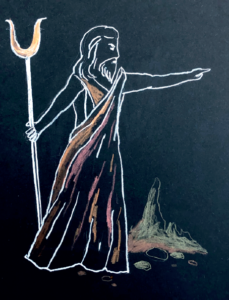 Roman name : Pluto
Roman name : Pluto
Hades, the somber other brother of Zeus was given the Kingdom of the Underworld, the place down below where all the souls end up after death.
The main entry of the underworld is guarded by the ferocious dog with 3 heads Cerberus . All dead souls need to pay Charon, the ferryman, for the passage through the Styx river. Another entry, located under the lake of Leornean is guarded by the monstrous Hydra with multiple heads.
Hades’s appearance is considered to be terrifying for the living. For many, just mentioning his name was frightening. When the Greeks were praying to him, they would clapped their hands on the ground to make sure he heard them performing their duties towards him. No one wanted to seem disrespectful to such a terrible god.
All the black animals, such as sheep, had to be sacrificed in his honour.
He is the reason why there is a winter.
After he felt in love with his niece Persephone and abducted her into his Underworld kingdom, his sister Demeter decided that nothing will grow till her beloved daughter wasn’t given back to her. As Persephone has eaten a seed of pomegranate in the underworld, her father Zeus had to find a compromise as there is an obscure divine law that imposed that whoever eats in the underworld is bound to stay.
The compromise was that the lovely Persephone would have to have to spend 4 months in the Underworld and therefore nothing on earth would grow; the other months she would returned to her mother and the earth would rejoice and be fertile.
Hades had a helmet that made its bearer invisible to all.
He was also the god of wealth as all the precious minerals came from beneath the ground.
How to recognise him ?
His attributes are the cornucopia, a key, a sceptre and the 3 headed dog Cerberus.
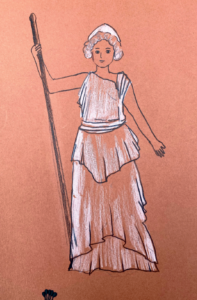 Roman name : Juno
Roman name : Juno
Hera is both a sister and the legitimate wife of Zeus. She is the goddess of marriage and the protector of women. She is tortured by her jealousy as her husband has so many extra marital affairs and she is famous for her vindictiveness.
She is the protector of the institution of mariage.
In honor of Hera, festivals were held in many cities of ancient Greece and were called Heraia. The most famous Heraia was held in Argos, Samos and Olympia.
How to recognise her ?
The attributes of Hera are either a sceptre as a symbol of sovereignty or a pomegranate as a symbol of fertility, but also a peacock or a cuckoo or a cow.
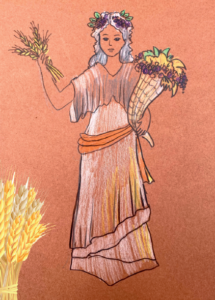 Roman name : Ceres
Roman name : Ceres
Demeter is the sister of Zeus and had a daughter with him the lovely Persephone.
She is the Goddess of vegetation and agriculture, of fertility and newly married couples.
The capture of her daughter Persephone by her other brother Hades broke the heart of Demeter. She wandered silently the Earth, wearing black scrutinising all the mortals in search of her darling daughter . The fields became barren. Zeus had to find a compromise and allowed Persephone to be reunited with her beloved mother for 9 months of the year. During these 9 months the nature would blossomed : in spring, summer and autumn. In winter , when Persephone must rejoin her husband Hades in his Underworld kingdom nothing grows : it is winter, cold, harsh and barren .
The Eleusinian Mysteries
Demeter and her daughter, Persephone, were central characters in the Eleusinian Mysteries, where initiates would accomplish rites from 1600 BCE to 392 CE.
Every year in spring time , the Ancient Athenians would celebrate this renaissance with the mystical Eleusinian festivals.
The Eleusinians were a secretive school in Eleusis in the northwest of Athens dedicated to celebrate Demeter and Persephone but as the initiated were condemned to death if they talked about the rituals performed, the mystery is still intact.
It is only known that during these rituals the initiates would be given such a vivid vision of their afterlife that it would free them from the fear of death as they understood that the soul stay intact through a continuous change of mortal bodies.
How to recognise her ?
Demeter attributes are a sceptre, a cornucopia, a torch and a wheat sheaf.
 Roman name : Vesta
Roman name : Vesta
Hestia, the first child and eldest daughter of Cronus and Rhea was the quietest and most peaceful goddess : she was the goddess of family, home and hearth, she was the eternal flame that would keep the family’s home warm.
The Ancients’ houses would always have a sanctuary in the center of them and the woman of the house would be responsible for keeping Hestia’s flame burning.
The fire of Hestia did travel as when a Greek city founded a new colony, they brought the sacred fire with them.
Hestia is permanently staying on mount Olympus, taking care of the sacred flame.
How to recognise her ?
Hestia’s attribute is a sceptre ( just like Hera which makes it some times difficult to identify one from the other).
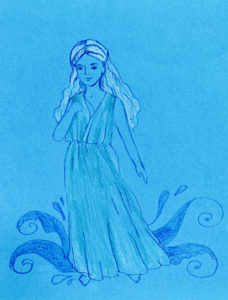 Roman name : Venus
Roman name : Venus
“ The power of Aphrodite is irresistible “
Hippolytus by Euripides
Aphrodite emerged from the sea foam when Uranus blood was spilled in the sea after being castrated by his own son Cronus .
Driven by Zephyrus, the god of the west wind, she was then transferred to Mount Olympus, where she was introduced to Zeus and the other gods, all were immediately and absolutely subdued.
She was and still is the symbol of feminine beauty.
She was quite naturally the goddess of love and desire, of beauty and pleasure.
Gods and mortals alike were all entangled and subdued by her beauty.
Aphrodite had many lovers but her greatest love was the God of War, Ares. Quite surprisingly she was tricked to marry the ugliest god : Hephaestus.
How to recognise her ?
Well, she can’t be missed as she is always so spectacularly beautiful with perfect features and proportions.
Still the list of her attributes are : the dove, the swan, the bee, the rose, the myrtle and the scallop shell.
The Other Olympian Gods : The Children of Zeus
Remember the rule : the child of two gods is a god, the child of one god and a mortal is a Demi or semi god ,: the child of 2 mortals can only be a hero at best.
But as with most rules there were exceptions.
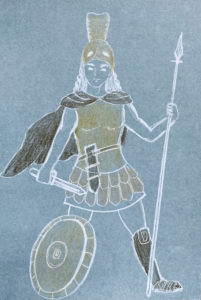 Roman name : Mars
Roman name : Mars
Ares was the son of Zeus and Hera.
He was the god of war, of violent battles, of bloodshed.
He is provocative and impulsive in nature. He symbolises the more violent aspects of war, ignoring any rule or law, in contrast to the other Goddess of war, Athena, celebrated for her strategic sense.
He is usually represented either naked with a powerful body dressed only with a helmet and a spear or as an armed warrior.
He was absolutely terrifying as he rushed to battle with scary eyes while screaming as loudly as ten thousands soldiers yelling. He was constantly thirsty for blood. He knew no mercy.
According to Homer all the gods despised him except his brother’s wife the goddess Aphrodite with whom he had a love affair.
How to recognise him ?
His attributes are either the boar, the serpent, the dog, the vulture, the spear and the shield.
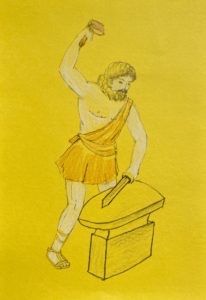 Roman name : Vulcan
Roman name : Vulcan
“Oh, Muses, sing in your clear voices of Hephaestus glorified for his inventions. With Athena the bright-eyed he showed men throughout the world how to use his wonderful gifts.
For until they had learned the crafts of Hephaestus, men lived like wild beasts in the mountain caves”…
Homeric Hymn to Hephaestus 2.1-7
The son of Zeus and Hera and in some versions the son of Hera alone as he was so hideous that some authors believed that Hera was responsible alone for his poor appearance. He could not possibly have any link to the majestic Zeus.
Hephaestus was such an ugly baby, that as soon as Hera, his mother, saw him, she threw him out of Olympus without a second thought. He ended up in the depths of the ocean and as a consequence would limped all his life. Thankfully the Nereid Thetis (who was to become Achilles mother) took care of him on the island of Lemnos.
Despite his unbecoming appearance which singled him out in Olympus, he was one of the most dedicated god to his trade : he was the god of construction and metallurgy, but also of craftsmanship, of fire and of volcanoes.
He was a master blacksmith and spend most of his time in his forge. That’s why all the myths related to him are related to his work : the winged sandals of Hermes, the creation of Pandora the first woman, the chain of Prometheus to the rock…..
He tricked her mother by imprisoning her to her throne and won back his destined place in Olympus and the hand of the most beautiful woman in the universe, the most celebrated Aphrodite, who had to marry him.
How to recognise him?
The characteristic symbol of Hephaestus is, of course, his hammer!
The temple of Hephaestus in the Agora in Athens is spectacular and is one of the best preserved Greek temples in the world.
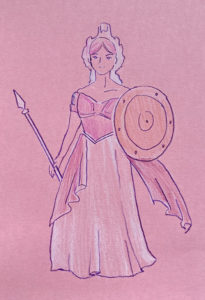 Roman name : Minerva
Roman name : Minerva
She was the goddess of wisdom, reason and strategic warfare.
Athena was Zeus’ favourite daughter.
The story of her birth is unique, she came out with the help of Hephaestus of Zeus’ forehead (from the centre of reason) in full armour . Her mother is the Oceanid Metis and embodied the concept of pure abstract thought.
She battled with Poseidon over the patronage of the city of Athens and won by offering an olive tree. The olive tree provided olives thus olive oil, fuel and shade from the sun, all more useful than the horses of Poseidon. The inhabitants of Athens voted in favour of Athena and decided to name their city by the name of their powerful protector Athena.
Protector of heroes, Athena is considered to be the wisest and one of the most important Olympian Gods.
How to recognise her?
She is symbolized by an owl and holds a spear and a shield made of goat’s skin. Her attribute could also be the olive tree.
The Temple of the Parthenon of the Acropolis in Athens is the most famous temple dedicated to her.
There were many festivals in honor of the Goddess but the Great Panathenaea in Athens was probably the largest celebration in honour of her.
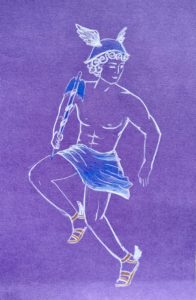 Roman name : Mercury
Roman name : Mercury
The son of Zeus and the nymph Maia, the cunning and clever Hermes was the messenger of the gods and also the god of roads and trade, of herds and flocks, of diplomacy, of language of writing, of astronomy, astrology, of wealth, thieves and travelers.
He was also the god of athletic competitions.
He was also known as the Messenger God, as he was the one delivering messages between the Gods and the mortals with his golden flying sandals.
Speed was in his essence as he was conceived and born within the course of one single day.
The Olympian God was also known as the soul barer, the one that would lead the soul of the dead to the Gates of the Underworld.
Last but not least he was considered to be the first teacher of the human race, introducing the letters and sciences to mankind and teaching them the use of the intellect.
How to recognise him ?
His symbol is one of the most well known through centuries : the caduceus, a staff given by Apollo with 2 serpents entwined. Not to confuse with the one of Asclepius even more famous symbol : a staff with one serpent entwined.
The caduceus with its 2 snakes symbolised the commerce and the negotiation, both essential for the trade.
The caduceus is often incorrectly used as the symbol of Asclepius and healthcare. Watch out !
 Roman name : Apollo
Roman name : Apollo
Apollo was the most handsome of all the gods, he was also extremely powerful as he was the god of the sunlight, the music , the poetry ,all art, prophecy, medicine and archery.
He was also the god of knowledge, logic, reasoning, rhetoric and harmony.
Born on the sacred island of Delos as his mother Leto, a minor goddess had to hide from the furry of Hera, he climbed Olympus from the very first day and joined the other Olympians.
He was the son of Zeus and the twin brother of Artemis.
Apollo was the teacher of the nine Muses.
Even more importantly he would ride every morning the sun chariot with its four horses in order to pull the sun across the sky every day.
He is supposed to have been born the seventh day of the month, the number 7 is sacred for the gods. So every seventh day of each month was dedicated to him and sacrifices were offered to him on this day.
His sanctuary at Delphi became the center of the Ancient World. The Oracle of Delphi was conveying Apollo’s words and the oracles would influence the political scene of the then known world.
The Pythian Games in Delphi were held in honor of Apollo and were one of the four Panhellenic Games of Ancient Greece, like the Olympic Games.
How to recognise him?
His symbols are the laurel wreath, the bow and arrow and the lyre whom he, according to the mythology, invented.
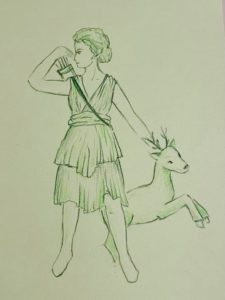 Roman name : Diane
Roman name : Diane
Apollo’s twin sister, Artemis, was the goddess of the moon, the wildlife and the hunt.
She would hunt but at the same time would protect the young animals from harm.
She, the maiden, is also the helper of midwives as the goddess of child birth..
The Temple of Artemis in Ephesus, or Artemission as it is also known, was one of the Seven Wonders of the Ancient World.
The festival of Artemis at Brauron was taking place every four years in honor of the Olympian Goddess, near Athens.
How to recognise her ?
She is usually represented with her bow and her quiver of arrows or by a stag or a hunting dog.
 Roman name : Bacchus
Roman name : Bacchus
The son of Zeus, Olympian Dionysus was the god of wine, fertility, festivities, religious ecstasy, and theatre. He was a god of contrasts and of supreme exaltation but also horror.
The cult of Dionysus was extremely popular in ancient Greece.
Son of Zeus and either the mortal Semeli or Persephone or Demeter , his father taught him how to grow grapes and make wine.
Dionysus did not want to hold on this secret for himself and began to go from city to city and teach it to mortals. He had many followers, hybrid creatures that accompanied him everywhere, like satyrs and maenads.
The cult of Dionysus also involved a communication between the living and the dead and Dionysus was called the dying and rising god and was considered to be a god of resurrection.
Dionysus succeeded to enter into the Underworld and take back his mother Semele with the help of Heracles who mastered Cerberus.
When Dionysus ‘s old school teacher got lost and was found wondering in the garden of king Midas, the cunning king brought him back to Dionysus who promised to grant him a favour.
The greedy Midas asked that whatever he touched should be turned into gold. Though Dionysus did warned Midas that his wish would turn into a curse he granted it. After his initial overwhelming joy, Midas soon discovered that all is food would turned into solid gold as his beloved daughter. Midas returned to Dionysus to beg him to end his wish, Dionysus agreed and asked Midas to wash his hands in the nearby Pactolus river thus the gold sands of Pactolus.
Many celebrations were dedicated to Dionysus, with the Dionysia festival being one of the largest celebrations in Ancient Greece.
How to recognise him ?
The bull, the snake, the phallus, the fig tree are his most common symbols.
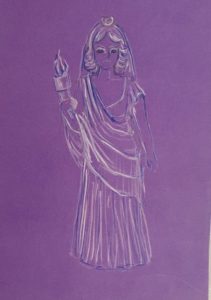 Roman name : Proserpine
Roman name : Proserpine
Persephone was the daughter of the goddess Demeter, the goddess of agriculture and fertility and Zeus her brother.
The capture of Persephone by her uncle Hades broke the heart of her mother Demeter, who then wandered silently the Earth, wearing black scrutinising all the mortals in search of her darling daughter . The fields became barren. Zeus had to find a compromise and allowed Persephone to be reunited with her beloved mother most of the year. During these months the nature blossoms : there are spring, autumn and summer . The other months, when Persephone must rejoin her husband Hades, nothing grows : it is winter.
The myth of Persephone essentially explained the changing of seasons and the circle of life and was the origin of the Eleusinian Mysteries, the most sacred religious rites in Ancient Greece.
How to recognise her ?
Her symbols are the pomegranate or the torch.
Roman name : Hercules
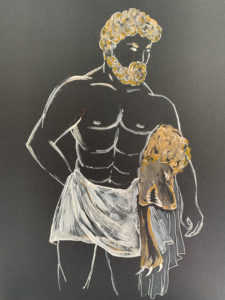 Heracles was the most popular god-hero in Ancient Greece. He was really the greatest of the divine heroes and he was so celebrated by the mortals but also by the gods that he was made a god, by his proud father Zeus, after his death.
Heracles was the most popular god-hero in Ancient Greece. He was really the greatest of the divine heroes and he was so celebrated by the mortals but also by the gods that he was made a god, by his proud father Zeus, after his death.
Everywhere in Ancient Greece, there would be a temple dedicated to him whereas for the other gods it would depend on their local popularity.
The life of Heracles with its ups and downs enabled everyone to relate to him. For all, he was the perfect hero.
Heracles is another illegitimate son of Zeus, this time with the sweet, beautiful and peaceful mortal Alcmene.
He was tricked by Hera to commit terrible crimes and had to atone by performing 12 Herculean labours.
After these 12 labours he was pardoned by the gods.
Years later he remarried with an obsessively jealous woman who poisoned his cloak.
While he was going through an excruciating painful agony, Hera finally agreed to reconcile and all the gods gleefully welcomed Heracles to Mount Olympus. Zeus, his mighty and proud father, had granted him immortality.
How do we recognise him?
He is almost always portrayed as a bearded muscular man with a club, most of the time wearing his lion’s skin.
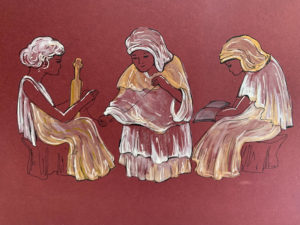 17- THE MOIRA OR THE FATES
17- THE MOIRA OR THE FATESthe 3 goddesses who determined human destinies especially the duration of one’s life and his share of misery.
Latin name : the Parcae : Nona, Decuma, Morta
There were 3 sisters:
Clotho : the spinner determines the thread of human fate,
Lachesis : the alloter who dispenses the good and bad fortune
Atropos : the inflexible who cut the thread of life.
The three sisters weaved the fate of humans and gods alike. Neither human nor God has the power to influence or question their judgment and actions.
Clotho, the youngest one, spins the thread of life; she is the very origin, the creation of life itself and her thread is spun upon the birth of a person.
Lachesis, the second sister, is the one that allocates the fate of people during life. The name comes from the Greek word ‘λαγχάνω’ which means to obtain from lots. In that sense, one can understand that their destiny is chosen out of a myriad of possibilities. It is said that Lachesis measures the thread of life with her rod, determining its length and nature.
The last sister of fate is Atropos, the unturning. Atropos is the cutter of the thread of life and with her shears she determines how someone will die.
According to the Greek mythology there are either 3 of the 6 children that Zeus had with the goddess of justice Themis, or in another version they are the children of Nyx alone.
How to recognise them ?
The fates are personified as 3 very old women.
Not to confuse with
*The Graeae: Deino, Enyo, Pemphredo or the Stygian Witches
The Walt Disney film “Hercules “ as well as Percy Jackson movies confuse the 3 Fates with the Graeae or Graiae old immortal witches who shared one eye and one teeth. The Graeae would read the future through the shared eye and then eat any mortal or hero like Perseus who came to ask for a prediction.
 Roman name : Fortuna
Roman name : Fortuna
The daughter of Aphrodite and Zeus or Hermes, Tyche was the goddess of fortune, chance and fate.
She was the personification of prosperity , growth, good fortune and abundance.
The goddess could as well make your good fortune or make your fortune disappear if you were not as grateful as you should .
How to recognise her ?
She holds a cornucopia or the wheel of fortune.
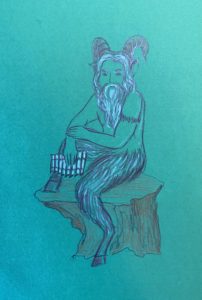 Latin name : Faunus or Sylvanus
Latin name : Faunus or Sylvanus
God Pan is a secondary and anthropomorphic deity. His father Hermes took him from his homeland in Arcadia, a mountainous region to Olympus where everyone became infatuated with him.
He was the god of nature, of the woods and the forests but also the personification of the power of life.
He was the protector of breeders, hunters, fishermen and shepherds, anyone with a permanent residence in nature.
He was also envied for his numerous love stories with the nymphs.
According to the Ancient Greek historian Plutarch, Pan has a unique characteristic as he supposedly died despite the fact that he is a god.
During the reign of the Roman Emperor Tiberius (14- 37 CE) a rumour spread that a divine voice from nowhere had whispers to a fisherman that “The Great God Pan is dead”, which is puzzling.
How to recognise him ?
Pan is represented as a handsome powerful man with horns on the top of his head and the lower legs of a goat. His symbol is the pan flute.
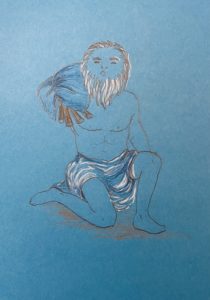 Latin name : Aeolus
Latin name : Aeolus
Aiolos, the son of a mortal king and an immortal nymph, was the god or the keeper of the winds . He had been appointed by Zeus. He was also king on the floating island of Aeolia, where he kept all the winds inside his huge shepherd’s bag, leaving them free only under the instructions of the major Olympic Gods.
Homer described in «The Odysseus» that Aeolus at first helped Odysseus and his crew when they reached his island Aeolia by giving to Odysseus a bag which trapped the four main winds so they could reach Ithaca rapidly. But Odysseus crew, just like Pandora, could not resist the temptation and they opened the bag while Odysseus was asleep. The ship was immediately blown back to Aeolia but Aeolus, infuriated by their immaturity, refused to help any longer.
Remember no one is allowed to disrespect a god.
How to recognise him ?
With his jar or bag where he keeps the winds, or a harp.
 Latin name : Cupid
Latin name : Cupid
The son of Aphrodite and Ares, Eros was the winged god of love.
According to the legend, if he would hit two people with his arrows they would immediately fall passionately in love.
For Hesiod, Eros was not the son of Aphrodite and Ares but one of the four primordial deities who created the world: “First there was Chaos, Gaia, Tartarus then Eros”. In Hesiod’s version, Eros does not bless someone with love but encourages it and facilitates birth and creation. He is a primordial force.
How to recognise him ?
His attributes are either the bow and harrows, or the lyre.
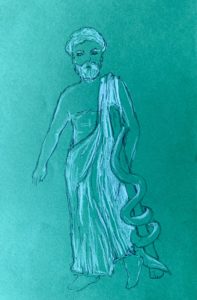 Latin name : Asclepius
Latin name : Asclepius
Asklepios, the son of Apollo, was the god of medicine and healings. He was worshiped all over Greece and especially in Epidaurus.
He was initiated into the science of healing and medicine by his mighty father Apollo but was taught the art of medicine by the centaur Chiron and by a snake he had rescued. Snakes were supposed to be sacred beings of healing and resurrection.
Askepios surpassed quickly Apollo and Chiron and soon Hades was in a terrible rage as Asclepius resuscitated too many creatures in the brink of his Underworld kingdom.
Zeus had to keep the delicate balance of life and death and therefore had to kill Asclepius with his thunderbolt.
Apollo retaliated immediately by killing the Titans who had forged the thunderbolts of Zeus.
Zeus punished Apollo by banishing him from Olympus and ordering him to serve for a whole year the king of Thessaly .
In order to reconcile with Apollo , Zeus accepted to resuscitate Asklepios with the obligation for him to stay in Mount Olympus and stop healing the mortals.
Even if Asklepios is not considered a major god, he is a central figure in the archetype of god-heroes-healers. Asklepios is the ideal conception of the healing power of nature, as it is perceived by humans today.
One of the greatest festivals in his honor was the Prominent Askleipia, which was originally held every 4 years in Epidaurus and lasted 7 days. The most famous temple of Asklepios was in Epidaurus , best known in modern times for its impressive theatre, Asklepios recommended to the sick people to be entertained as an important part of the healing process.
The original Hippocratic Oath starts with this reference : “ I swear by Apollo and by Hygieia and Panacea and by all the gods…..”
The daughters of Asklepios were Hygieia the goddess of cleanliness and Panacea, the goddess of universal remedy.
Hippocrates of Kos was a physician in the age of Pericles considered to be the apotheosis of the Ancient Greek civilisation ( 460-370 BCE). He is considered as the Father of Medicine. The Hippocratic oath is still being used worldwide by doctors in medicine.
How to recognise him ?
His symbol is probably the most famous attribute from the Greek Mythology: it is a rod or a staff with one serpent entwined. It is still use nowadays to identify pharmacies.
Many people confused this healing symbol with the attribute of the god Hermes who uses a staff with 2 serpents entwined.
Other Gods : Some Titans made peace with Zeus and stayed present with the Olympian gods such as :
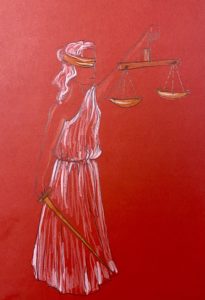 According to Hesiod, Themis was a Tintaness. she was one of the daughter of Gaia and Uranus, one of the sisters of Chronos and Rhea. She was the goddess of divine order, natural law and fairness.
According to Hesiod, Themis was a Tintaness. she was one of the daughter of Gaia and Uranus, one of the sisters of Chronos and Rhea. She was the goddess of divine order, natural law and fairness.
Her law was sacred and applied equally to the gods, superior even to their will. Her laws must be respected over the laws of the men.
She also could predict the future. She had links with Apollo and was present at Delos to witness the birth of Apollo.
If Themis was not respected then Nemesis would take over and inflict the punishment.
How to recognise her ?
She is usually depicted wearing a blindfold, holding a bronze sword, believed to represent her ability to cut fact from fiction. She can also be represented holding scales of justice.
Finally there were the Monsters, no gods but not growing old.
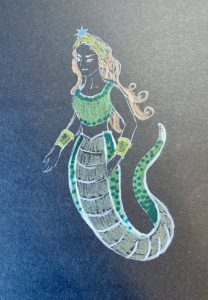 Most of the famous monsters from Greek Mythology had the same mother : Echidna the mother of Monsters. In some versions Echidna was the daughter of Tartarus and Gaia.
Most of the famous monsters from Greek Mythology had the same mother : Echidna the mother of Monsters. In some versions Echidna was the daughter of Tartarus and Gaia.
Hesiod’s Echidna was half beautiful maiden and half fearsome snake. Hesiod described «the goddess fierce Echidna» as a flesh eating «monster, irresistible», who was like neither «mortal men» nor «the undying gods», but was «half a nymph with glancing eyes and fair cheeks, and half again a huge snake, great and awful, with speckled skin», who «dies not nor grows old all her days.»
Echidna and her off springs lived to challenge many future Heroes. Some of her descendants were:
 For the ancient Greeks the most powerful manifestation of nature was the wind or more accurately the winds.
For the ancient Greeks the most powerful manifestation of nature was the wind or more accurately the winds.
The wind would change the seasons, bring the clouds and the needed rain but also punish men with hail, storms and thunder.
The wind would either protect the soil or let it be parched and scorched by the blazing sun.
And even more importantly the ancient Greeks had discovered that no living creature could live if his or her inner wind would stop: the respiration.
Life depended on winds.
In Homer it is explained that the ruler over the winds was Aeolus, he would keep all the winds locked up in a bag and would only release them only when he or the gods decided to reward or punish the humans.
The mighty Aeolus also known by his title as “ the keeper of winds” was credited with 12 sons , their mother was Eos, the Titan goddess of the dawn.
The Gods of the Winds are always depicted as men with wings attached to their shoulders, but usually with different expressions and attributes
The four most important sons and winds were called the Anemoi, the ones corresponding to one of the four cardinal directions (North, South, West, East) from which they came.
The four gods were :
Boreas, the cruel North Wind, was often described as a bearded old and rough man with wings, who held a conch shell. He was closely associated with winter, as he was the bringer of cold and low temperatures.
The Athenians venerated Boreas because they believed that it was the North Wind who helped them to destroy the Persian fleet in 492 BCE.
Notus, the Southern wind, was considered dangerous as it would blow after midsummer, causing the crops to burn and bringing the bad weather of late summertime.
He was usually represented as a young man with long hair, with dew coming from his wings
He kept in his hands a vessel for water, a hydria — from which the rain gushed out.
Eurus the beneficial Eastern wind was represented as a matured man slightly bold. He was also known by the surname of Argestus, the bearer of brightness.
He also brought the bad storms, but he was more kind to people than his brothers Boreas and Notus. He was described as a curly-headed man with an unkempt beard and with a sadness in his face.
The Spartans worshiped Eurus considered there as the Saviour of Sparta because of his refreshing rain.
Zephyrus, the light Western wind pictured as a young handsome man, often with his lover the nymph Claris, who would spread flowers .
He would bring the spring time and end the harsh winter. He was of course the favourite of every one and especially of the poets.
But there were also :
Notus and his closest brothers Euronotus and Lips or Livos or sometimes also Libanotos would send warm and even burning hot wind
In Athens you can visit the beautiful “Tower of the Winds” in the Roman Agora in Plaka, it is considered to be the world’s first meteorological station.
The tower, which was built as a horologion (time-clock) in the first century BCE by the Syrian architect Andronicus Cyrrhestes, was made on the ground-plan of the eight angles corresponding to the eight gods of winds. The reliefs of the eight personifications of the winds decorate the frieze all around the tower.
 It is extremely difficult to identify a god as he or she can take any appearance.
It is extremely difficult to identify a god as he or she can take any appearance.
Firstly and most importantly a god is immortal and does not grow old. He or she is never unwell , never suffer any illness or pain.
They eat nectar and drink amboisie, which are supposed to be the best of the best food and drink. They have incredible powers over the men and over nature.
Now how could you recognise a God hidden under a human appearance ? It took us an agonising long time to find the answer, here it is :
About the difference between a god and a common mortal one can reasonably argue that in the 21st century, the difference has faded
Thanks to technology and science we have so much power over things and nature, we have so much knowledge in a tiny computer, we drive we don’t know how many horses , we can cross the Atlantic in a few hours we can talk to someone in the International Space Station so outside our planet.
So , really the only thing that keeps us human is … our shadow.
It should be important to consider properly one’s shadow as it is a permanent reminder that we are mortal and soon will have to dissolve into the world of the shadows, the kingdom of Hades.
There is still one difference between us and the gods but quite essential : we are mortals….
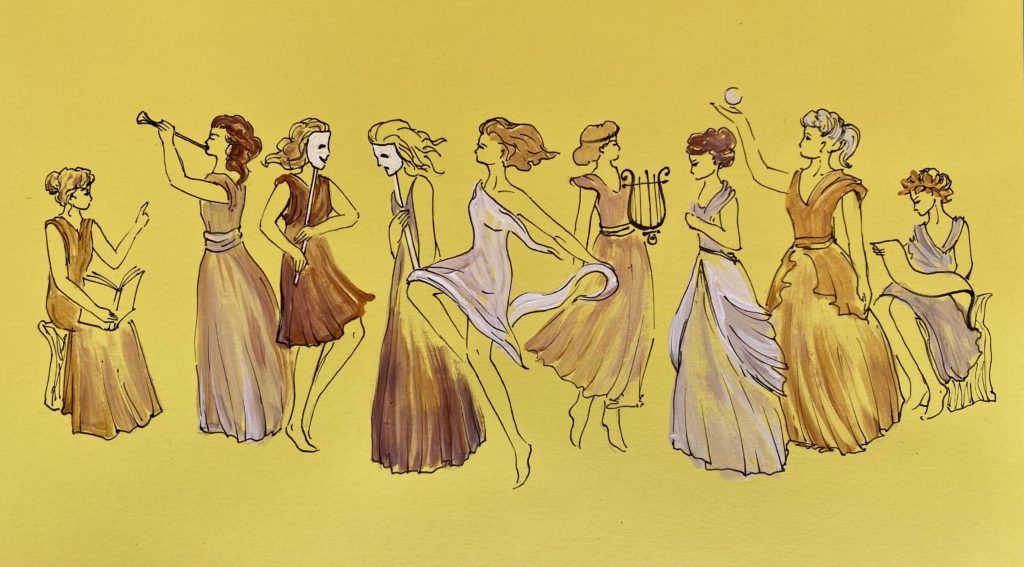
Sing to me oh Muse… Oh please sing to me…..
Sing in me, Muse, and through me tell the story…
The Muses were the daughters of the mighty Zeus and the Titaness Mnemosyne, his aunt, the goddess of memory in Greek mythology. Mnemosyne conceived the nine Muses after sleeping with Zeus for nine consecutive nights.
Mnemosyne is celebrated in the first few lines of epic poems like “The Iliad” and “The Odyssey”, among others.
Towards the goddess we have kept our devotion alive with words we still use today such as memories, mnemonic, and mnemonics which refer to her.
Their nine daughters were beautiful young women who were at the same time the goddesses as well as the representations of science, literature, and the arts. They were educated by Apollo and provided the inspiration of every knowledge and of the arts. They were the forces of the creative mind.
Hesiod, in his Theogony, claimed to have encountered the Muses on Mount Helicon, who whispered in his ears the story of the gods , transforming the simple shepherd into one of the most important poets in antiquity.
The poet has stated that the Muses were created to help people forget their troubles and their suffering, perhaps as a balance to their mother Mnemosyne, the goddess of memory.
Hesiod revealed that they were called Muses, as the ancient Greek word “mosis” refers to the desire and wish. The word museum also comes from the Greek Muses.
Who Were They ?
Calliope, named the“beautiful-voiced,» was the Muse of epic poetry and the goddess of eloquence.
She had two sons, Orpheus and Linus, and was said to be the wisest and most assertive of the Muses.
How to recognise her ?
She is usually represented wearing a gold crown and carrying a writing tablet, a scroll, or a book in her hand
Clio , whose name means“to make famous” or “celebrate,» was the Muse of history.
She had one son, Hyacinth.
How to recognise her ?
She is usually depicted with an open scroll or seated by a set of books.
Erato, meaning the “lovely” or “beloved,» was the Muse of lyric poetry, especially love and erotic poetry. Her name comes from the Greek word “Eros” that refers to the feeling of falling in love.
How to recognise her ?
She is usually depicted with a wreath of myrtle and roses and holding a kithara (lyre), or a golden arrow. Erato is often represented accompanied by Eros holding a torch.
Euterpe, whose name can be translated “the giver of much delight,» is the Muse of music and dialectic.
She discovered several musical instruments.
How to recognise her ?
She is usually shown holding or playing an aulos (double flute).
Melpomene, which means: “to celebrate with dance and song,» was initially the Muse of singing but later she became the Muse of tragedy. Opposite from Thalia, she invented tragedy, rhetoric speech and Melos. To create beautiful lyrical phrases, it was traditional to call on Melpomene for inspiration.
How to recognise her ?
She is most usually portrayed with a “tragic mask” and wearing the boots traditionally worn by tragic actors or holding a knife or sword in one hand and the tragic mask in the other.
Polyhymnia or “the one of many hymns,» was the Muse of sacred poetry, sacred hymns and eloquence. She was also sometimes credited as being the Muse of geometry and meditation.
How to recognise her ?
She is usually represented as very serious, in meditation and pensive while holding a finger to her mouth and wearing a long cloak.
Terpsichore,whose name can be translated as” delight in dancing “ was the Muse of dance and dramatic chorus. She invented dances, the harp and ….. education, schools, lessons and tutoring….
She is the mother of the sirens : one of them Parthenope, drowned herself in desperation when her songs failed to entice Odysseus.
How to recognise her ?
She is often shown sitting down or standing up while holding a lyre.
Thalia, “the joyous» or «the flourishing,» is the Muse of comedy and idyllic poetry.
She also discovered comedy, geometry, architectural science and agriculture.
How to recognise her?
Thalia is usually portrayed as a young woman with a joyous air wearing a crown of ivy, boots, and carrying a comic mask in her hand. Many statues also depict her holding a bugle and a trumpet (objects used to amplify actor’s voices in ancient comedy) or a shepherd’s staff.
Urania , translation : “heavenly” or “of heaven,» was the muse of astronomy and astronomical writings.
She could foresee the future by the arrangement of the stars.
She inherited Zeus’ power and majesty and Mnemosynes’ beauty and grace, and was often associated with universal love.
How to recognise her ?
She is commonly portrayed dressed in a cloak embroidered with stars with her eyes and with a celestial globe.
Was There a Tenth Muse ?
The poetess Sappho of Lesbos was given the title of the «Tenth Muse” by Plato. But it was an honorific title, demonstrating Plato’s admiration for the poetess about whom we know very little.
Why Are the 9 Muses so Important ?
The nine Muses and their gifts of song, dance, and joy helped the gods and the ancient Greeks forget their troubles and focus on art and beauty.
A world filled with beauty, poetry and knowing was the epitome of civilisation for the Ancient Greeks who laid the foundations to the Western civilisation.
How could we not be grateful ?
 The Underworld where all the dead have to live (?) is the kingdom attributed by Zeus to Hades. The dark, taciturn and quite frightening god lives in his kingdom with his wife Persephone when she is not staying with her mother, the goddess Demeter.
The Underworld where all the dead have to live (?) is the kingdom attributed by Zeus to Hades. The dark, taciturn and quite frightening god lives in his kingdom with his wife Persephone when she is not staying with her mother, the goddess Demeter.
It is an invisible kingdom only accessible to the dead.
At any entrance of the Underworld some terrifying monsters were on guard : the most famous is Cerberus , also called the Hound of Hades, a monstrous black dog with 3 heads, a serpent is his tail, and snakes are slithering from the different parts of his body.
There was also the horrific Lernaean Hydra , guarding the entrance by the Lernaean lake.
These terrible creatures prevent any living to get into the kingdom of Hades but more importantly prevent any escape from the dead.
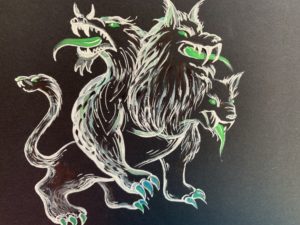 The Ancient Greeks believed that at the time of death the corpse freed the soul which would keep the shadow of the person. This soul wrapped in the shadow would be transported to the entrance of the Underworld where everyone would be sent to the appropriate place according to their respective merits or offences towards the gods.
The Ancient Greeks believed that at the time of death the corpse freed the soul which would keep the shadow of the person. This soul wrapped in the shadow would be transported to the entrance of the Underworld where everyone would be sent to the appropriate place according to their respective merits or offences towards the gods.
In front of the main entrance to the Underworld lived all the related gods, mostly those who came late at the time when Zeus was handing responsibilities, only the hardships were left : 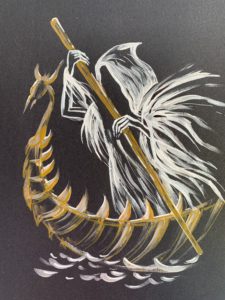
Once the dead souls were carried by one of these gods or goddesses of darkness and misery, or by Hermes for the case of glorious warriors they were then gathered inside the Underworld.
But they still needed to cross one of the five rivers of the Underworld, each associated with an emotion :
—the Styx (the river of Hatred)
-the Acheron (the river of Pain)
-the Lethe (the river of Oblivion)
-the Phlegethon (the river of fire)
-the Cocytus (the river of wailing).
Just a precision: the Oceanus was the river that encircled the whole world, the living territories and the Underworld, not a crossing river inside the Underworld.
Not every dead was allowed to cross the river. Only the dead who had a coin placed under their tongue or on their closed eyes were able to pay the sad, unpleasant and filthy ferryman Charon and were then allowed to cross.
This explains why the Ancient Greeks were terrified by the idea of not being buried properly. It was the most terrible punishment as without a proper burial of your mortal body and the appropriate rituals to the gods there was no way to cross the river. Therefore your soul would be condemned for eternity to scream of despair and drowned continuously in the river Styx ( Hatred) or in the Acheron ( Pain).
Once the dead had paid their fare to the terrifying Charon who was said to have fiery eyes , they boarded the ferry to cross the river where the lost souls were desperately screaming.
On the other side of the river, Cerberus, the hound of Hades, a monstrous black dog with 3 heads was standing guard.
Behind Cerberus, the 3 Judges of the Underworld, Monos, Rhadamanthus and Eaque were there to decide where the souls of the dead were to go depending on how they used the lives that were lend to them.
The Underworld was divided into different sections :
It was the most populated place as it was where ordinary souls who did not commit any crime or outrage towards the gods would be sent. These souls had to walk aimlessly as in the life given they did not achieve any success.
It was the place where the souls that had wasted their lives on unrequited love, on repeated failures were condemned as it was considered an outrage to the gods to waste the life that had been given.
They had to work hard for eternity.
It was the place for the nobles, the heroic warriors, the heroes, the pures, the people who had made a significant contribution to the society.
It was the blissful place for “the happy few”.
The Isles of the Blessed
It was the VIP ( Very Important People) section within The Elysian Fields, reserved to the true heroes, blessed by the gods.
The doomed place of darkness and torment, initially it was the void where The Olympian gods could imprison their ennemis . The most famous prisoner of Tartarus was Cronus .
Then it became the terrible prison for all those who had outraged the gods.
The Underworld is mostly a quiet, peaceful place ruled by the cold Hades. Only the wicked are punished and the few, happy few live a pleasant after-life. For the very large majority it is a place of shadows. It is not the sinister painful hell depicted by other religions.